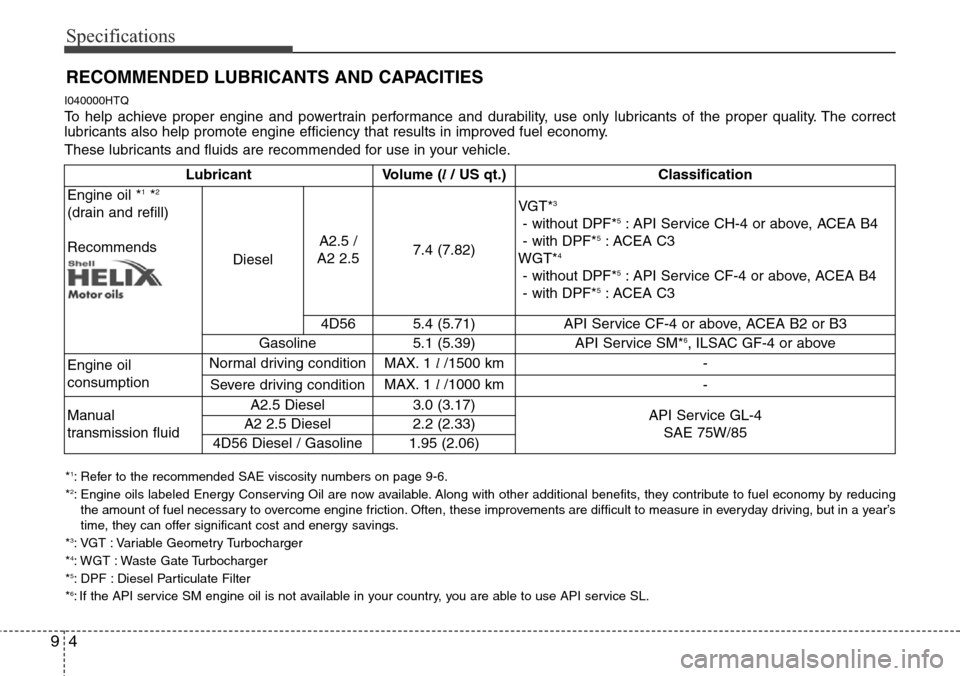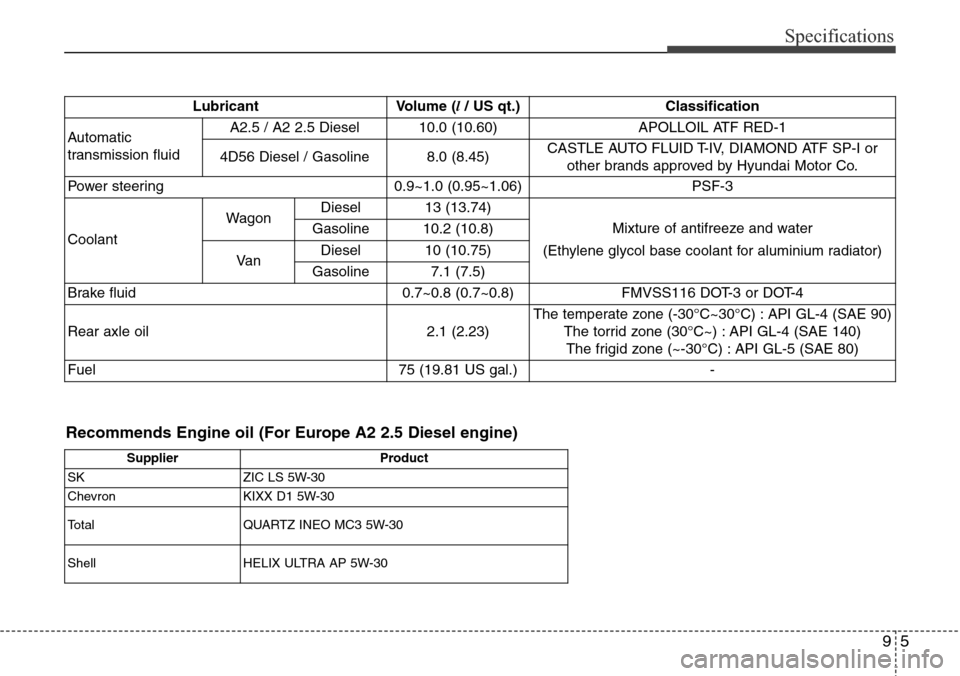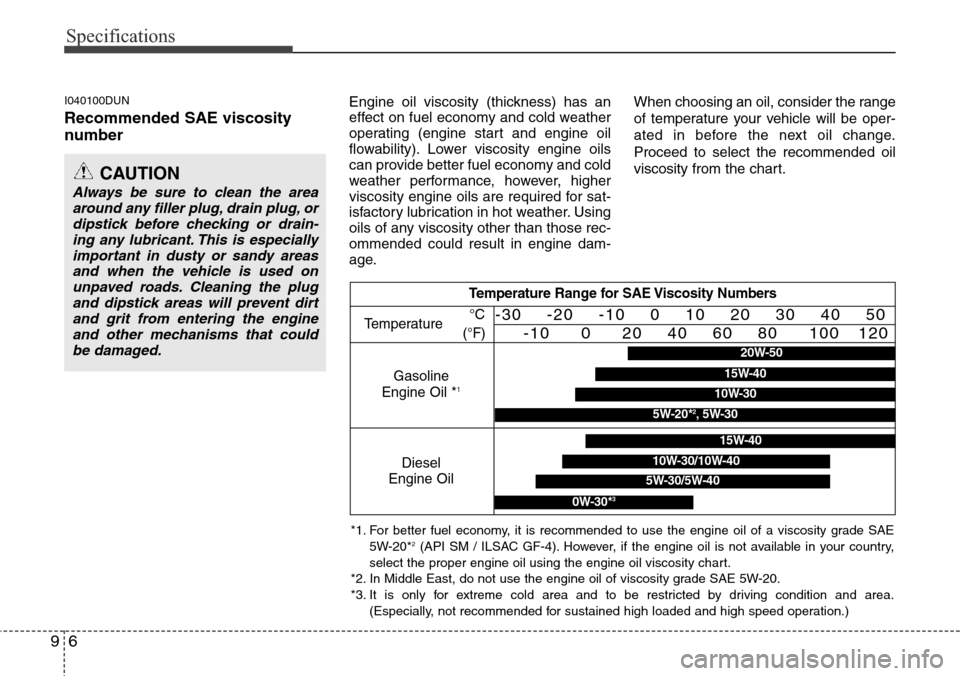2011 Hyundai H-1 (Grand Starex) Engine oil specifications
[x] Cancel search: Engine oil specificationsPage 10 of 338

Introduction
4 1
Fuel Additives
HYUNDAI recommends that you use
good quality gasoline that meets Europe
Fuel standards (EN228) or equivalents.
For customers who do not use good
quality gasoline including fuel additives
regularly, and have problems starting or
the engine does not run smoothly, one
bottle of additives added to the fuel tank
at every 15,000km (for Europe)/5,000km
(except Europe). Additives are available
from your authorized HYUNDAI dealer
along with information on how to use
them.
A020107AUN
Operation in foreign countries
If you are going to drive your vehicle in
another country, be sure to:
• Observe all regulations regarding reg-
istration and insurance.
• Determine that acceptable fuel is avail-
able.
Diesel engine
A020201DUN
Diesel fuel
Diesel engine must be operated only on
commercially available diesel fuel that
complies with EN 590 or comparable
standard. (EN stands for "European
Norm").Do not use marine diesel fuel, heating
oils, or non-approved fuel additives, as
this will increase wear and cause dam-
age to the engine and fuel system.
The use of non-approved fuels and/or
fuel additives will result in a limitation of
your warranty rights.
Diesel fuel of above cetane 51 is used in
your vehicle. If two types of diesel fuel
are available, use summer or winter fuel
properly according to the following tem-
perature conditions.
• Above -5°C (23°F) ... Summer type
diesel fuel.
• Below -5°C (23°F) ... Winter type diesel
fuel.
Watch the fuel level in the tank very care-
fully : If the engine stops through fuel fail-
ure, the circuits must be completely
purged to permit restarting.
A020202BUN
Biodiesel
Commercially supplied Diesel blends of no
more than 7% biodiesel, commonly known
as "B7 Diesel" may be used in your vehicle
if Biodiesel meets EN 14214 or equivalent
specifications. (EN stands for "European
Norm"). The use of biofuels exceeding 7%
made from rapeseed methyl ester (RME),
fatty acid methyl ester (FAME), vegetable
oil methyl ester (VME) etc. or mixing diesel
exceeding 7% with biodiesel will cause
increased wear or damage to the engine
and fuel system. Repair or replacement of
worn or damaged components due to the
use of non approved fuels will not be cov-
ered by the manufactures warranty.
CAUTION
Do not let any gasoline or water
enter the tank. This would make it
necessary to drain it out and to
bleed the lines to avoid jamming the
injection pump and damaging the
engine.
CAUTION- Diesel Fuel
(if equipped with DPF)
It is recommended to use the regu-
lated automotive diesel fuel for
diesel vehicle equipped with the
DPF system.
If you use diesel fuel including high
sulfur (more than 50 ppm sulfur)
and unspecified additives, it can
cause the DPF system to be dam-
aged and white smoke can be emit-
ted.
Page 11 of 338

15
Introduction
A020202AUN
Biodiesel (for New Zealand)
Commercially supplied Diesel blends of
no more than 7% biodiesel, commonly
known as "B7 Diesel" may be used in
your vehicle if Biodiesel meets EN 14214
or equivalent specifications. (EN stands
for "European Norm"). The use of biofu-
els exceeding 7%, made from rapeseed
methyl ester (RME), vegetable oil methyl
ester (VME) etc. or mixing diesel exceed-
ing 7% with biodiesel will cause
increased wear or damage to the engine
and fuel system. Repair or replacement
of worn or damaged components due to
the use of non approved fuels will not be
covered by the manufactures warranty.
A090000AEN
As with other vehicles of this type, failure
to operate this vehicle correctly may
result in loss of control, an accident or
vehicle rollover.
Specific design characteristics (higher
ground clearance, track, etc.) give this
vehicle a higher center of gravity than
other types of vehicles. In other words
they are not designed for cornering at the
same speeds as conventional 2-wheel
drive vehicles. Avoid sharp turns or
abrupt maneuvers. Again, failure to oper-
ate this vehicle correctly may result in
loss of control, an accident or vehicle
rollover.Be sure to read the “Reducing
the risk of a rollover” driving guide-
lines, in section 5 of this manual.
A030000AUN
No special break-in period is needed. By
following a few simple precautions for the
first 1,000 km (600 miles) you may add to
the performance, economy and life of
your vehicle.
• Do not race the engine.
• While driving, keep your engine speed
(rpm, or revolutions per minute)
between 2,000 rpm and 4,000 rpm.
• Do not maintain a single speed for long
periods of time, either fast or slow.
Varying engine speed is needed to
properly break-in the engine.
• Avoid hard stops, except in emergen-
cies, to allow the brakes to seat prop-
erly.
• Don't let the engine idle longer than 3
minutes at one time.
• Don't tow a trailer during the first 2,000
km (1,200 miles) of operation.
CAUTION
• Never use any fuel, whether
diesel, B7 biodiesel or otherwise,
that fails to meet the latest petro-
leum industry specification.
• Never use any fuel additives or
treatments that are not recom-
mended or approved by the vehi-
cle manufacturer.
VEHICLE BREAK-IN PROCESS VEHICLE HANDLING
INSTRUCTIONS
Page 336 of 338

Specifications
4 9
RECOMMENDED LUBRICANTS AND CAPACITIES
I040000HTQ
To help achieve proper engine and powertrain performance and durability, use only lubricants of the proper quality. The correct
lubricants also help promote engine efficiency that results in improved fuel economy.
These lubricants and fluids are recommended for use in your vehicle.
*1: Refer to the recommended SAE viscosity numbers on page 9-6.
*2: Engine oils labeled Energy Conserving Oil are now available. Along with other additional benefits, they contribute to fuel economy by reducing
the amount of fuel necessary to overcome engine friction. Often, these improvements are difficult to measure in everyday driving, but in a year’s
time, they can offer significant cost and energy savings.
*
3: VGT : Variable Geometry Turbocharger
*4: WGT : Waste Gate Turbocharger
*5: DPF : Diesel Particulate Filter
*6: If the API service SM engine oil is not available in your country, you are able to use API service SL.
LubricantVolume (l/ US qt.)
Classification
Engine oil *1*2
(drain and refill)
Recommends
DieselA2.5 /
A2 2.57.4 (7.82)VGT*3
- without DPF*5: API Service CH-4 or above, ACEA B4
- with DPF*5: ACEA C3
WGT*4
- without DPF*5: API Service CF-4 or above, ACEA B4
- with DPF*5: ACEA C3
4D56 5.4 (5.71) API Service CF-4 or above, ACEA B2 or B3
Gasoline 5.1 (5.39) API Service SM*
6, ILSAC GF-4 or above
Engine oil
consumptionNormal driving conditionMAX. 1 l/1500 km
-
Severe driving conditionMAX. 1 l/1000 km
-
Manual
transmission fluid A2.5 Diesel 3.0 (3.17)
API Service GL-4
SAE 75W/85
A2 2.5 Diesel2.2 (2.33)
4D56 Diesel / Gasoline 1.95 (2.06)
Page 337 of 338

95
Specifications
LubricantVolume (l/ US qt.)
Classification
Automatic
transmission fluidA2.5 / A2 2.5 Diesel10.0 (10.60)APOLLOIL ATF RED-1
4D56 Diesel / Gasoline8.0 (8.45)CASTLE AUTO FLUID T-IV, DIAMOND ATF SP-I or
other brands approved by Hyundai Motor Co.
Power steering 0.9~1.0 (0.95~1.06) PSF-3
CoolantWagonDiesel 13 (13.74)
Mixture of antifreeze and water
(Ethylene glycol base coolant for aluminium radiator) Gasoline 10.2 (10.8)
Va nDiesel 10 (10.75)
Gasoline 7.1 (7.5)
Brake fluid 0.7~0.8 (0.7~0.8) FMVSS116 DOT-3 or DOT-4
Rear axle oil 2.1 (2.23)The temperate zone (-30°C~30°C) : API GL-4 (SAE 90)
The torrid zone (30°C~) : API GL-4 (SAE 140)
The frigid zone (~-30°C) : API GL-5 (SAE 80)
Fuel 75 (19.81 US gal.) -
Recommends Engine oil (For Europe A2 2.5 Diesel engine)
Supplier Product
SK ZIC LS 5W-30
Chevron KIXX D1 5W-30
Total QUARTZ INEO MC3 5W-30
Shell HELIX ULTRA AP 5W-30
Page 338 of 338

Specifications
6 9
I040100DUN
Recommended SAE viscosity
number
Engine oil viscosity (thickness) has an
effect on fuel economy and cold weather
operating (engine start and engine oil
flowability). Lower viscosity engine oils
can provide better fuel economy and cold
weather performance, however, higher
viscosity engine oils are required for sat-
isfactory lubrication in hot weather. Using
oils of any viscosity other than those rec-
ommended could result in engine dam-
age.When choosing an oil, consider the range
of temperature your vehicle will be oper-
ated in before the next oil change.
Proceed to select the recommended oil
viscosity from the chart.
CAUTION
Always be sure to clean the area
around any filler plug, drain plug, or
dipstick before checking or drain-
ing any lubricant. This is especially
important in dusty or sandy areas
and when the vehicle is used on
unpaved roads. Cleaning the plug
and dipstick areas will prevent dirt
and grit from entering the engine
and other mechanisms that could
be damaged.
Temperature Range for SAE Viscosity Numbers
Temperature
Gasoline
Engine Oil *
1
°C
(°F)-30 -20 -10 0 10 20 30 40 50
-10 0 20 40 60 80 100 120
Diesel
Engine Oil
5W-30/5W-40
15W-40
10W-30/10W-40
0W-30*3
*1. For better fuel economy, it is recommended to use the engine oil of a viscosity grade SAE
5W-20*2(API SM / ILSAC GF-4). However, if the engine oil is not available in your country,
select the proper engine oil using the engine oil viscosity chart.
*2. In Middle East, do not use the engine oil of viscosity grade SAE 5W-20.
*3. It is only for extreme cold area and to be restricted by driving condition and area.
(Especially, not recommended for sustained high loaded and high speed operation.)
20W-50
10W-30
15W-40
5W-20*2, 5W-30